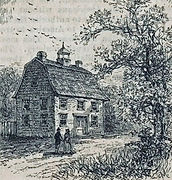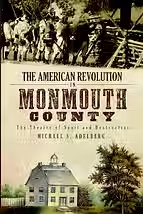
250 for the 250th
Celebrating the 250th Anniversary of
the American Revolution in Monmouth County
by Historian and Author Michael Adelberg
©2025

Monmouth Courthouse, 1778
We now understand that the American Revolution was more complicated than a contest between the George Washington’s Continental Army and the red-coated British. In no locality are these complications more evident than Monmouth County, New Jersey, where Patriots and Loyalists clashed in brutal, localized civil warfare. This local war transformed the county in multiple ways. It ushered in a new set of leaders whose ambitions were previously blocked by British rule; it sparked new industries such as privateering and salt-making that brought new people and capital to the shore region, and it re-structured the county’s most important institutions, including its churches, annual elections, and courts.
While some of the clashes and incidents that occurred in Monmouth County—such as the Battle of Monmouth and the hanging of Captain Joshua Huddy by vengeful Loyalists—are well-narrated, dozens more remain largely unnarrated. The 250th anniversary of the American Revolution is the ideal time to compile and narrate the most important events and activities that occurred in Revolutionary Monmouth County.
Articles by Year
Click the year to be taken to all articles for that year, then click the article title
1774
1775
1776
1777
1778
1779
1780
1781
1782
1783

Own the book inspired by these articles! Makes a great gift for the history lovers in your life!
About the Author

Michael Adelberg has been researching the American Revolution in Monmouth County, New Jersey, for over thirty years. He is the author of the award-winning The American Revolution in Monmouth County, and three other books. His essays on the American Revolution have appeared in The Journal of Military of History, The Journal of the Early Republic, The Wilson Quarterly, and other scholarly journals. Adelberg’s research has been recognized by the New Jersey Historical Commission, the New Jersey Studies Academic Alliance, the David Library of the American Revolution, the public television program NJ Today, and the government of Monmouth County.
Other Resources
250 for the 250th FAQs
1. How were topics selected for the articles in 250 for the 250th? Article topics were selected based on two criteria: 1.) the importance of the topic to the people who lived in Revolutionary Era Monmouth County; 2.) adequate source materials to draft the article. The Battle of Monmouth was the largest Revolutionary War event to occur in Monmouth County but it is not narrated in 250 for the 250th. That is because the Battle of Monmouth is already the subject of an excellent book, Fatal Sunday, by Mark Lender and Garry Wheeler Stone. However, several topics related to the battle and its impact on the people of the Monmouth County are the subject of articles. 2. Are the articles in 250 for the 250th written about elsewhere? The articles in 250 for the 250th fall into one of three categories: a.) Discussed by modern historians, but not easily accessible. For example, David Fowler wrote an outstanding PhD dissertation about the Pine Robbers. The dissertation was written for a scholarly audience and never published as a book. Few people will read Fowler’s research. So, there are articles about the Pine Robbers in 250 for the 250th even though Fowler already well-covered this topic. b.) Discussed in local histories and antiquarian works. Several topics in 250 for the 250t are narrated in antiquarian sources or local histories. Some of these narratives are balanced and well-researched, some are not. Either way, Revolutionary War topics in these works hopscotch sources and are spread across dozens of older books. So, many topics covered in these histories are included in 250 for the 250th. c.) Original source materials. A number of topics in 250 for the 250th have never been narrated (for example, the raising of Monmouth County’s state troops). Shards of information exist across original documents and were pasted together for the first time in these articles. I enjoyed being the first historian to write on these topics. 3. How are antiquarian and genealogical materials used in 250 for the 250th? The articles in 250 for the 250th are built on source materials—those written by people who witnessed the American Revolution. If there are not source materials sufficient to write on a topic, that topic is not part of this collection. However, antiquarian and genealogical sources often add important details not contained in source materials. So many of the articles include supporting information from antiquarian and genealogical materials. 4. Modern historians discuss some aspects of the American Revolution in Monmouth County. How are these works used in 250 for the 250th? The articles in 250 for the 250th are ground in and written from source materials. In a number of articles, specific historians who contributed an original analysis or critique on the article’s topic are mentioned and their works are cited. 5. What is the likelihood that there are errors in the 250 for the 250th articles? The articles in this series are built on source materials and these materials offer the most reliable information about the Revolutionary era. But source materials reflect the bias of the author and sources sometimes disagree. For example, casualty counts in Continental and British narratives of the same event frequently disagree. Source materials are often imprecise with regard to specific dates, name spellings, and locations. In many articles, I make suppositions based on probability and context. Qualifying terms such as “likely” and “potentially” are used alert readers to suppositions. In any collection as large as 250 for the 250th there is inevitably a small amount of human error. If a reader believes an error might exist in an article, the reader is encouraged to bring it to my attention, and forward the source material that can correct the record. Readers can contact me at 250@monmouthhistory.org . 6. Were any edits made to source materials when transcribed into the articles in 250 for the 250th? In some articles, small edits were made to made to increase the readability of a particular document. 18th Century sentences were often extremely long and packed with qualifying language that can confuse a modern reader. So, some punctuation edits were made, archaic abbreviations are modernized, and some qualifying text is removed (replaced with “…”). In all cases, edits were minor and made only for the purpose of increasing the readability of the source. 7. Should there be more articles about poor people, women, and minorities in 250 for the 250th? The articles in 250 for the 250th are built on surviving sources and the body of surviving sources tilts heavily toward political and military leaders. When the body of surviving documents allows it, I selected topics that shed light on how the American Revolution impacted poor people, women, and minorities (particularly Africans-Americans in Monmouth County). Even when articles focus on political and military leaders, I seek to discuss the article topic’s impact on ordinary people. 8. Is 250 for the 250th the complete story of the American Revolution in Monmouth County? 250 for the 250th is the most complete account of the American Revolution in Monmouth County, but it is not the complete story. There are many important and interesting topics that lacked enough documentation to develop an article. Below are five examples of interesting topics that are not explored in 250 for the 250th due to lack of source materials: •Free African-American communities •The handfuls of American-Indians, Catholics, and Jews in Revolutionary Monmouth County •The Mattisonia Grammar School near Freehold and education in the county •Refugeetown on Sandy Hook (home to the Black Brigade and other Loyalist partisans) •Rebuilding villages razed by Loyalist raiding parties.
Name Index
For a name index throughout articles, the following searchable PDF is available. Tip: Use Crtl+F to find the names easily.
Tables
Here is the link to the tables page.
Citations
This entirety of this work is protected under US copyright. When using the information, please cite appropriately. This online citation generator offers various styles. Sample citation:
Michael Adelberg, “[Article Title],” 250 for the 250th, Monmouth County Historical Association, 2025, [url].
Teacher Resource
Click here for a guided classroom activity!


